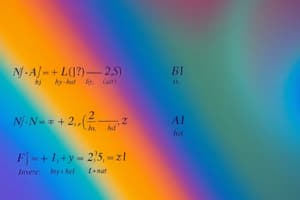Podcast
Questions and Answers
Which operation can be performed on vectors to find their direction and magnitude?
Which operation can be performed on vectors to find their direction and magnitude?
- Dot product (correct)
- Vector subtraction
- Scalar multiplication
- Cross product
Parametric equations can only describe linear motions.
Parametric equations can only describe linear motions.
False (B)
What is the relationship between polar coordinates and rectangular coordinates?
What is the relationship between polar coordinates and rectangular coordinates?
Polar coordinates represent points in the plane using a radius and an angle, while rectangular coordinates use an x and a y value.
A _______ is a set of points in a plane that satisfies a quadratic equation.
A _______ is a set of points in a plane that satisfies a quadratic equation.
Match the following conic sections with their definitions:
Match the following conic sections with their definitions:
Which formula would you use to find the sine of the sum of two angles?
Which formula would you use to find the sine of the sum of two angles?
The domain of the function arcsin(x) is from -1 to 1.
The domain of the function arcsin(x) is from -1 to 1.
What is the result of applying De Moivre's Theorem to find the cube of the complex number (2 + 3i)?
What is the result of applying De Moivre's Theorem to find the cube of the complex number (2 + 3i)?
The Law of _____ states that the ratio of the length of a side of a triangle to the sine of its opposite angle is constant.
The Law of _____ states that the ratio of the length of a side of a triangle to the sine of its opposite angle is constant.
Match the inverse trigonometric functions with their corresponding range:
Match the inverse trigonometric functions with their corresponding range:
What does the amplitude of a trigonometric function represent?
What does the amplitude of a trigonometric function represent?
All trigonometric functions have the same period of 2π.
All trigonometric functions have the same period of 2π.
What is the rectangular form of the complex number represented in polar form as 5(cos(θ) + i sin(θ))?
What is the rectangular form of the complex number represented in polar form as 5(cos(θ) + i sin(θ))?
Flashcards
Vector in the Plane
Vector in the Plane
A directed line segment with both magnitude and direction, represented by an arrow.
Vector Components
Vector Components
The components of a vector represent its horizontal and vertical changes, used to break it into smaller parts.
Parametric Equations
Parametric Equations
A way to describe a curve using parameters, where x and y coordinates are expressed in terms of a third variable (t).
Polar Coordinates
Polar Coordinates
Signup and view all the flashcards
Conic Sections
Conic Sections
Signup and view all the flashcards
Trigonometric Identities
Trigonometric Identities
Signup and view all the flashcards
Trigonometric Equations
Trigonometric Equations
Signup and view all the flashcards
Inverse Trigonometric Functions
Inverse Trigonometric Functions
Signup and view all the flashcards
Law of Sines
Law of Sines
Signup and view all the flashcards
Law of Cosines
Law of Cosines
Signup and view all the flashcards
Complex Numbers
Complex Numbers
Signup and view all the flashcards
Complex Plane
Complex Plane
Signup and view all the flashcards
Polar Form of Complex Numbers
Polar Form of Complex Numbers
Signup and view all the flashcards
Study Notes
Second Quarter Pre-Calculus Topics
-
Trigonometric Identities and Equations:
- Understanding fundamental trigonometric identities (Pythagorean, reciprocal, quotient) is key for solving equations and simplifying expressions.
- Apply sum/difference, double angle, and half-angle formulas to solve and simplify trigonometric expressions.
- Use algebraic and graphical methods to identify and solve trigonometric equations.
- Recognize and validate solutions, accounting for potential extraneous solutions in trigonometric equations.
-
Inverse Trigonometric Functions:
- Understand and apply inverse trigonometric functions (arcsin, arccos, arctan) to solve equations and find angles.
- Know the domains and ranges of inverse trigonometric functions and graph them.
- Use inverse trigonometric functions in application problems (angles in triangles, etc.).
- Calculate compositions of trigonometric and inverse trigonometric functions.
- Analyze graphs of inverse trigonometric functions.
-
Applications of Trigonometry:
- Apply trigonometric functions to solve right triangle problems (side lengths, angles).
- Solve oblique triangles using the Law of Sines and Law of Cosines.
- Understand and apply oblique triangle solutions to real-world problems.
- Use trigonometric functions in navigation, surveying, and real-world scenarios.
- Model periodic phenomena (tides, sound, light) using trigonometric functions, understanding amplitude, period, and phase shift.
-
Complex Numbers:
- Understand complex numbers and their representation in the complex plane (Argand diagram).
- Perform operations on complex numbers (addition, subtraction, multiplication, division).
- Understand the polar form of complex numbers and their relationship with trigonometric functions, converting between rectangular and polar forms.
- Use De Moivre's Theorem to raise complex numbers to powers, find roots, and apply these techniques in problem-solving.
-
Vectors in the Plane:
- Define vectors as directed line segments.
- Understand vector components for decomposing vectors.
- Perform vector operations (addition, scalar multiplication, dot product) and find magnitudes/directions.
- Understand geometric interpretations of vector operations and their connection to complex numbers.
- Apply vectors to solve physics problems (displacement, velocity, acceleration) and geometry problems.
-
Parametric Equations:
- Understand parametric equations to define curves in the plane.
- Convert between parametric and rectangular equations of curves.
- Analyze graphs of parametric equations.
- Use parametric equations to model motion and real-world scenarios.
- Relate parametric equations, their graphs, and alternative curve descriptions.
-
Polar Coordinates:
- Apply polar coordinates to represent points in the plane.
- Convert between polar and rectangular coordinates.
- Analyze graphs of polar equations.
- (Later): Use polar coordinates for evaluating integrals in calculus.
- Graph and recognize polar equation formats.
-
Conic Sections:
- Understand definitions, properties, and equations of conic sections (circle, ellipse, parabola, hyperbola).
- Identify conic section equations and use them to solve problems.
- Calculate centers, foci, vertices, and other key aspects of conic sections.
- Graph conic sections and use graphs to solve problems.
- Connect conic sections to other mathematical areas (algebra, geometry, calculus).
Studying That Suits You
Use AI to generate personalized quizzes and flashcards to suit your learning preferences.




